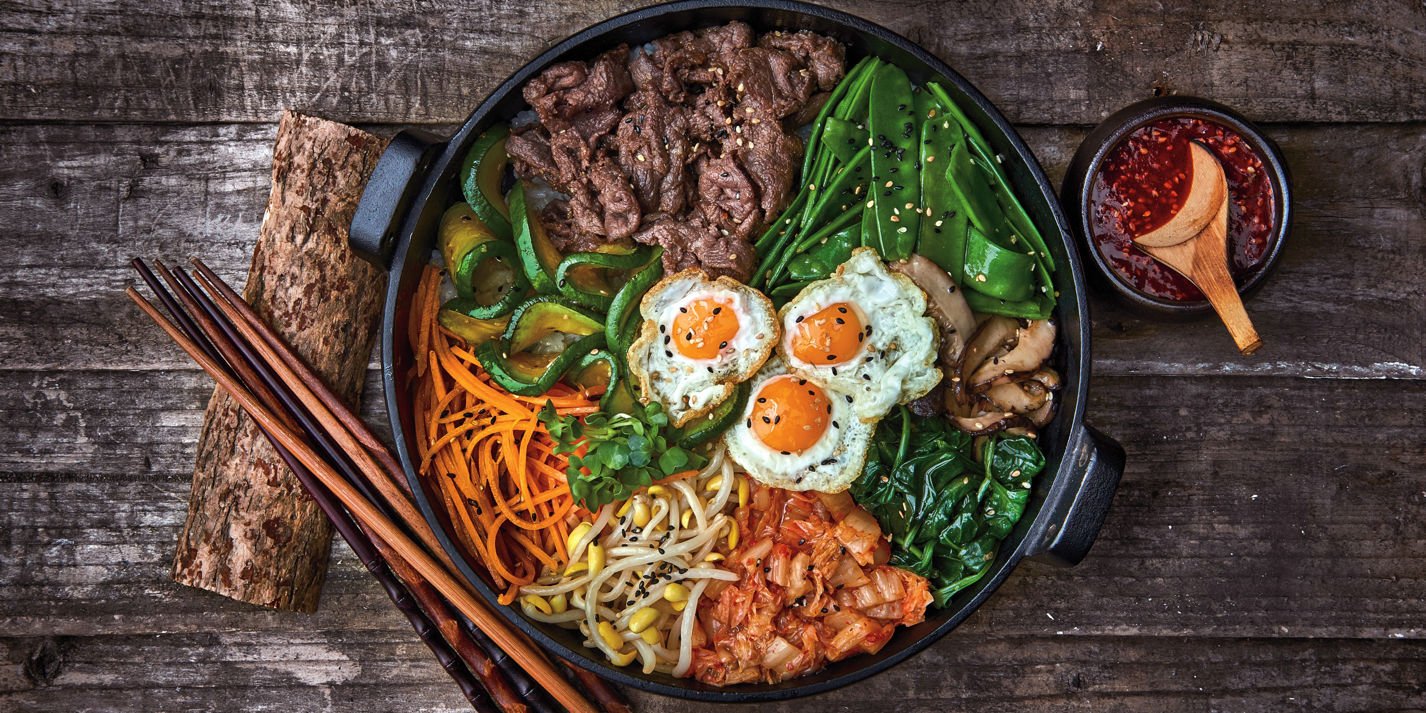Korea’s Most Colorful Rice Bowl of Comfort
Have you ever eaten a dish that felt like a perfect harmony of flavors, colors, and textures—all in one bite? That’s Bibimbap for you. It’s not just food; it’s an experience. A rainbow in a bowl. A warm hug with spice. A dish that speaks of balance, love, and simplicity.
Bibimbap (비빔밥) means “mixed rice” in Korean. But it’s so much more than that. It’s a bowl of freshly steamed rice topped with assorted sautéed vegetables, a choice of protein (like beef, tofu, or even mushrooms), a soft or crispy egg, and a generous spoonful of gochujang (Korean red chili paste). Once served, you mix it all up before taking your first bite—and with every mouthful, you get a little bit of everything.
I still remember the first time I made Bibimbap at home. I was intimidated at first. So many toppings, so many steps. But here’s the secret: it’s all about prep, not perfection. You don’t need to cook everything at once. Once the vegetables are sliced and lightly cooked, the rest comes together beautifully.
Let’s cook Bibimbap together. Not rushed. Not complicated. Just delicious and full of joy.
Ingredients – What You’ll Need
This Bibimbap recipe is for 2 people and can easily be adjusted. The ingredients might look like a lot, but don’t worry—most are vegetables that cook quickly.
For the rice base:
- 2 cups cooked short-grain rice (white or brown)
- 1 teaspoon sesame oil
Vegetables:
- 1 cup spinach (or other leafy greens)
- ½ cup bean sprouts
- ½ cup zucchini, thinly sliced
- ½ cup carrots, julienned (cut into matchsticks)
- 4-5 shiitake mushrooms (or any mushrooms), thinly sliced
- 1 small cucumber, sliced thin (optional)
- Cooking oil for sautéing (any neutral oil)
Protein:
- 2 eggs (sunny-side up or your favorite style)
- Optional: Marinated beef or tofu (recipes below)
For the gochujang sauce:
- 2 tablespoons gochujang (Korean chili paste)
- 1 tablespoon sesame oil
- 1 tablespoon sugar or honey
- 1 tablespoon water
- 1 teaspoon rice vinegar
- ½ teaspoon minced garlic
For garnish:
- Toasted sesame seeds
- Green onions, sliced
- Extra gochujang (for spice lovers!)
Tip: Bibimbap is flexible. If you don’t have all the veggies listed, use what you’ve got—bell peppers, cabbage, corn, tofu, bok choy. It’s a great way to use leftovers too.
Step-by-Step – Let’s Make Bibimbap
Step 1: Cook the Rice
Start with the rice because it takes the longest.
- Wash your rice 2–3 times until the water runs mostly clear.
- Cook it according to package instructions. Short-grain white rice is traditional, but brown rice or even quinoa works if you want something healthier.
- Once cooked, fluff with a fork and keep it warm.
Pro tip: Add a few drops of sesame oil into the rice before serving—it gives it an amazing nutty aroma.
Step 2: Prep the Sauce
The gochujang sauce is where all the flavor magic happens.
In a small bowl, whisk together:
- 2 tbsp gochujang
- 1 tbsp sesame oil
- 1 tbsp sugar (or honey)
- 1 tbsp water
- 1 tsp rice vinegar
- ½ tsp garlic
Mix until smooth. Adjust sweetness or spice depending on your taste.
Love it spicier? Add more gochujang or a pinch of chili flakes.
Step 3: Prepare the Vegetables
Now comes the fun part—sautéing or blanching the veggies. Each ingredient is cooked separately so that its color and flavor stay distinct.
Spinach:
- Blanch spinach in boiling water for 30 seconds.
- Drain, rinse under cold water, and squeeze out excess moisture.
- Season with a pinch of salt, ½ tsp sesame oil, and a sprinkle of sesame seeds.
Bean Sprouts:
- Blanch for 2–3 minutes, drain, and rinse.
- Season similarly with a pinch of salt, sesame oil, and sesame seeds.
Carrots:
- Lightly sauté in a pan with a touch of oil for 1–2 minutes until soft but still bright.
Zucchini:
- Sauté zucchini slices with a little oil and a pinch of salt until just tender (2–3 minutes).
Mushrooms:
- Sauté sliced mushrooms until browned and cooked through. A few drops of soy sauce here can add extra umami.
Optional cucumber:
- Raw or lightly salted, for a fresh crunch.
Arrange everything in small bowls. It helps when assembling the final dish.
Step 4: Cook the Egg
You can go classic with a sunny-side up egg—the runny yolk mixes beautifully with the spicy sauce and rice.
- Heat a nonstick pan with a bit of oil.
- Crack in the egg and cook until the whites are set but yolk remains soft.
- For a crispier version, fry it until the bottom edges turn golden brown.
Step 5: Optional Protein – Beef or Tofu
If you want to make your Bibimbap more filling, add a protein of your choice.
Korean-style Beef (Bulgogi-style):
- 100g thinly sliced beef
- 1 tsp soy sauce
- ½ tsp sesame oil
- ½ tsp sugar
- ½ tsp garlic
- Pinch of pepper
Marinate the beef for 10 minutes, then cook in a hot pan until browned and tender.
Tofu:
- Pan-fry firm tofu slices until golden on both sides.
- Season with a bit of soy sauce or even a splash of teriyaki for a fusion twist.
Step 6: Assemble Your Bibimbap Bowl
Now, the most satisfying step—putting it all together.
In a wide bowl:
- Place a scoop of hot rice in the center.
- Arrange the vegetables around the rice in colorful sections—spinach, sprouts, mushrooms, carrots, zucchini, etc.
- Place the cooked beef or tofu (if using) on one side.
- Gently slide the fried egg on top.
- Add a big spoonful of the gochujang sauce in the center.
- Garnish with sesame seeds and green onions.
Take a moment to admire your masterpiece—it’s a true feast for the eyes.
Step 7: Mix and Eat!
Right before eating, grab your chopsticks or spoon and mix everything thoroughly. Let the yolk break, the sauce blend, and the veggies mingle with the rice.
Every bite should be slightly different—spicy, nutty, crunchy, smooth, hot, and cool. That’s the beauty of Bibimbap.
Why Bibimbap is So Loved
- It’s customizable: You can make it vegetarian, vegan, gluten-free, spicy, mild, low-carb—you name it.
- It’s nutritionally balanced: Whole grains, proteins, fresh veggies, and healthy fats.
- It’s visually stunning: It looks like art in a bowl!
- It’s comforting and satisfying without being heavy.
Tips and Variations
- Don’t skip the sauce! The gochujang mix ties everything together.
- If you want extra texture, try using a hot stone bowl (dolsot) to create crispy rice at the bottom.
- Store leftovers in separate containers. The veggies and rice will last 2–3 days in the fridge.
Final Thoughts
Bibimbap might seem like a fancy restaurant dish at first glance, but at its heart, it’s the simplest kind of cooking: take what you have, treat each part with care, and bring it all together with love. Whether you’re cooking for yourself, your family, or friends, it’s a dish that always impresses without being complicated.
And once you’ve made it once, you’ll start seeing your leftovers differently. That lone carrot, a handful of spinach, the last spoon of rice—all have a place in your next Bibimbap bowl.
So grab your favorite bowl, start prepping, and enjoy the delicious balance of this iconic Korean meal.


September 18, 2025 at 8:59 amReading this evokes subtle awareness, with each phrase inviting reflection and patience. The text promotes contemplative presence and appreciation of nuanced insight.